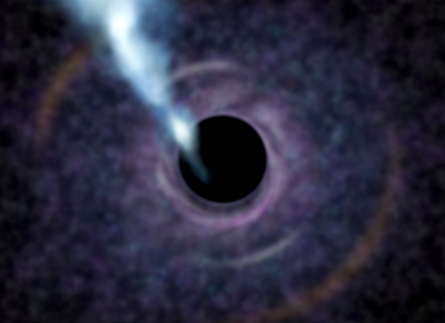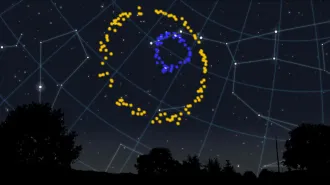SEATTLE — Astronomers have determined with high precision that the black hole at the heart of the nearby galaxy M87 weighs the equivalent of 6.6 billion suns. The finding makes the monster the most massive known in Earth’s cosmic neighborhood and the heaviest black hole measured so far using the orbits of stars.

More than doubling a widely accepted estimate, the new M87 measurement for the first time puts the mass of a local supermassive black hole — some 50 million light-years from Earth — on a par with the estimated 10-billion-solar-mass heft of black holes in distant galaxies, said Karl Gebhardt of the University of Texas at Austin. He described the findings on January 12 at the winter meeting of the American Astronomical Society.
Because more massive black holes have larger event horizons — the boundary inside which any incoming particle remains forever trapped — the new result makes it more likely that astronomers will one day glimpse the shadow of this boundary region in M87, a feat that would clinch the existence of these gravitational beasts (SN: 10/9/10, p. 22).
The finding corroborates simulations by Gebhardt and a collaborator that suggest supermassive black holes in other nearby galaxies are about twice as heavy as had been calculated (SN: 7/4/09, p. 5).
Extremely massive black holes are rare “and having one so close to us is extraordinary,” commented astronomer Avery Broderick of the Canadian Institute for Theoretical Astrophysics in Toronto. The Milky Way’s central black hole weighs the equivalent of a mere 4 million suns.
To weigh M87’s black hole, Gebhardt’s team used precision optics on the Gemini North telescope atop Hawaii’s Mauna Kea to measure the speeds of groups of stars orbiting the galaxy’s core at different distances. The speedup of stars closest to the center gives a precise measure of the black hole’s pull, allowing researchers to calculate its mass. The researchers also used data gathered by a telescope at the McDonald Observatory in west Texas.
Now, says Gebhardt, “it’s time to push the limit” and use Gemini to measure the supermassive black holes in more distant galaxies. If astronomers can show that those black holes have a maximum mass, it may put a cap on how heavy galaxies can become.







